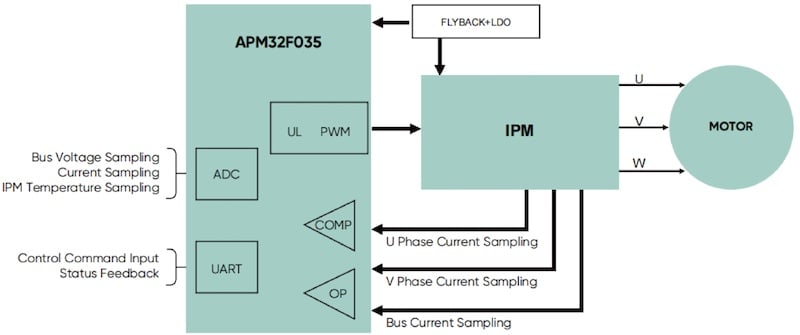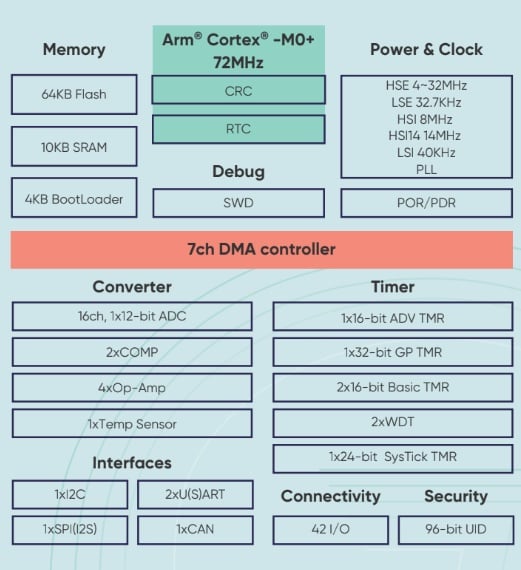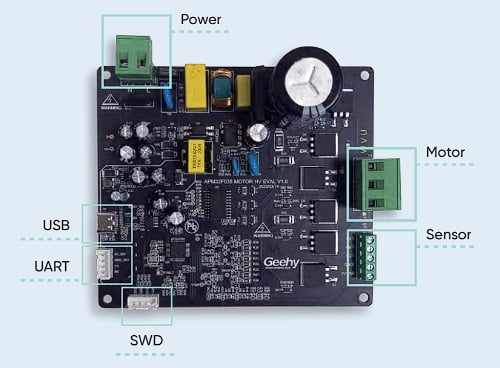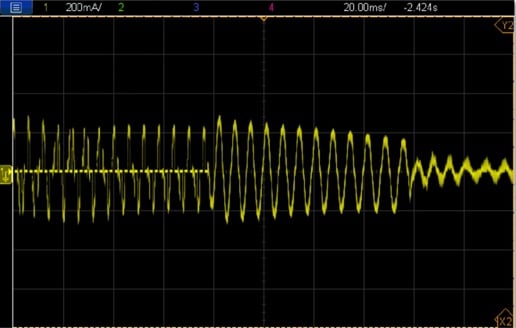Leveraging Advanced Microcontroller Features to Improve Industrial Fan Performance
Getting the most performance out of industrial fans can be a tricky task. In this article, learn how dedicated microcontroller features can smooth the way to implement advanced algorithms such as Field-Oriented Control (FOC).
Industrial fans require high efficiency, smooth motion, and low noise. Advanced algorithms such as Field-Oriented Control (FOC) can effectively accomplish these goals albeit at a significant computational and economic cost. However, dedicated motor control microcontrollers with integrated FOC mitigate cost and computation issues, and some designs can also address other problems, such as position detection and smooth bidirectional startup.

Figure 1. In a typical industrial fan, integrated FOC technology improves performance. Image provided courtesy of Pixabay
In this article, we will examine industrial fan controllers and the concepts behind FOC, followed by a discussion of issues faced by engineers when implementing motor control for industrial fans. Next, we’ll explore how Geehy Semiconductors’s APM32F035 MCU addresses the specific challenges of industrial fans.
Industrial Fan Controllers
A fan controller regulates the speed of a fan motor, controlling the air movement produced. However, adjusting the fan's speed impacts more than just the air movement: it allows the control of noise level and energy consumption.
Figure 2 shows a simple block diagram of a control system for a brushless three-phase interior permanent magnet (IPM) DC motor. In this example, space vector pulse width modulation (SVPWM) is used to modulate the three-phase voltage required by the motor.
Note that comparators, operational amplifiers, and ADC are all integrated in this system, providing an all-in-one solution for the entire control system. This high degree of integration aids in boosting system performance and simplifying the tasks of implementation for engineers.

Figure 2. Block diagram of a motor control system. Image provided courtesy of Geehy
A vital aspect of a motor controller is the control algorithm used. The type of algorithms may be based on the type of motor (e.g., trapezoidal or sinusoidal), whether position sensors are used, and what the speed and current control requirements are.
Field-Oriented Control
As microcontrollers have increased in capacity, the motor control industry has begun to look at more complex, high-end control algorithms such as FOC. The motor control system presented in Figure 2 uses FOC, also known as vector control. Vector control is for 3-phase AC electric motors, including 2-phase stepper motors and brushless DC (BLDC) motors (the type used in Figure 2).
FOC aims to achieve maximum torque at a given speed, and it accomplishes this by ensuring that the rotor field lags 90 degrees behind the stator. To achieve this, the control system must
- Measure the motor currents.
- Measure the rotor position (either using speed and position sensors or inferring it indirectly)
- Transform the motor currents into a coordinate system that rotates with the rotor.
- Calculate the rotor flux angle
- Control the currents in the stator windings to achieve the 90 degree rotor lag
FOC supports smooth acceleration and deceleration over the entire speed range and it generates full torque at startup. It has proven ideal when there is a need for highly accurate control in high-performance motion applications—including industrial fans.
Critical Issues for Industrial Fan Performance
Through the years, much progress has been made in controllers for BLDC motors, especially with the increase in processing power and the use of dedicated MCUs. However, engineers still face challenges when dealing with industrial fan motor control, including efficient use of power, noise control, and smooth performance. FOC can mitigate these particular problems, but its typical implementation remains problematic, requiring additional components, such as external sensors that increase cost and lead to a longer bill of materials (BoM).
Another issue for industrial fan performance is initial position detection, which is essential for industrial fans because of its impact on initial startup and running performance along with the possibility of unintended reversals. The conventional startup sequence of standard motors encompasses three distinct stages: positioning, acceleration, and loop closure. During the positioning phase, the potential for unintended reversals may arise.
In addition, high-speed bidirectional startup remains a challenge: when high winds are present, the fan may already be in motion before activation. It must be determined if the motor is already in motion before activating the fan's operation. For example, gradual deceleration should occur when the motor is on the verge of reversing due to headwinds. While solutions exist, they need to provide the performance engineers seek.
Boosting Fan Performance By Leveraging MCU Special Features
As we’ve discussed so far, improving industrial fan performance can be a challenging task. Implementation of FOC and other functions can be tricky for system designers. Fortunately, today’s advanced CPUs now offer sophisticated technology that meets these needs. An example along those lines is Geehy’s APM32F035 MCU.
The chip is a 32-bit FOC motor control dedicated MCU and is based on the Arm Cortex-M0+ core operating at 72 MHz. An M0CP co-processor that includes a shift unit, 32-bit/32-bit divider, multiply-add operation, square root, trigonometric functions, and SVPWM further enhances performance. The block diagram of Figure 3 summarizes various features of the APM32F035.

Figure 3. Block diagram of the Geehy APM32F035. Image provided courtesy of Geehy
The MCU also integrates motor-specific PWM for complementary and brake modes linked with M0CP. Figure 4 shows the high-voltage motor control evaluation board, but a low-voltage evaluation board is also available.

Figure 4. High voltage motor control evaluation board for the APM32F035. Image provided courtesy of Geehy
Integrated FOC
The APM32F035 MCU includes an integrated vector computer with dedicated math accelerators that comprehensively support computationally intensive FOC control algorithms. This integration eliminates the need for external sensors, enhances efficiency, and provides effective open-loop startup. It also reduces overall design costs, including a reduced BoM.
Initial Position Detection
Conventional startup methods struggle to address initial position detection (IPD) effectively, but the APM32F035, with its innovative initial position detection feature, aids in overcoming this limitation. While saturated or variable inductance is typically the industry standard, the MCU amplifies the current within the designated red region, injecting six pulses to achieve a precise and discernible signal, as illustrated in Figure 5.

Figure 5. Geehy implementation of IPD. Image provided courtesy of Geehy
High-Speed Bidirectional Startup
To address issues with motion due to high wind, Geehy takes the approach illustrated in Figure 6, which shows the motor's phase current. The APMF32F035 uses forward/reverse wind detection logic to trigger the startup process upon detecting the motor's operation. The graph demonstrates the forward wind startup, illustrating the process.

Figure 6. Illustration of wind detection logic. Image provided courtesy of Geehy
Solving Problems for Industrial Fan Systems
The APM32F035 solves problems for several industrial fan applications. For strong gas exhaust fans, it supports constant power control, perfect protection control, and an optimized start algorithm. High-speed ventilators benefit from ultra-high-speed operation, field weakening control, and upwind/downwind start. Industrial exhaust fans experience a 100% successful start rate for both upwind/downwind start, along with perfect protection control.
The APM32F035 presents numerous advantages as a choice for industrial motor control applications; other uses include small and large household appliances, E-bikes, high-pressure water pumps, and gardening tools. It offers a motor control solution with embedded FOC, highly efficient algorithms, and a powerful CPU.
Industry Articles are a form of content that allows industry partners to share useful news, messages, and technology with All About Circuits readers in a way editorial content is not well suited to. All Industry Articles are subject to strict editorial guidelines with the intention of offering readers useful news, technical expertise, or stories. The viewpoints and opinions expressed in Industry Articles are those of the partner and not necessarily those of All About Circuits or its writers.







